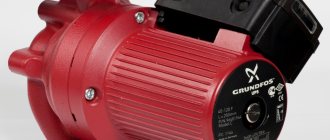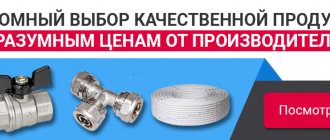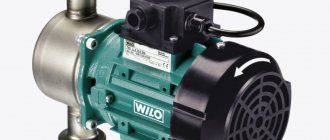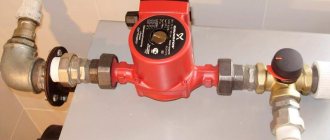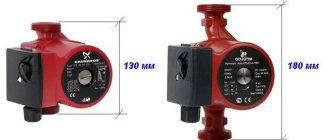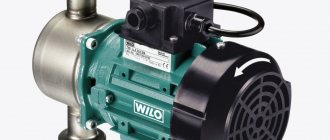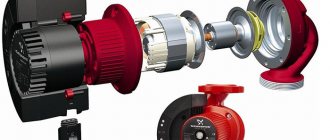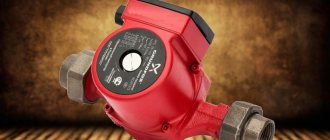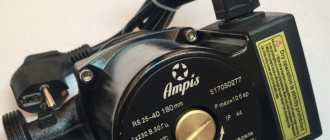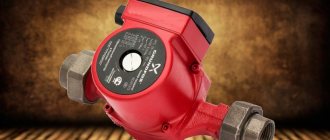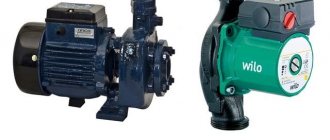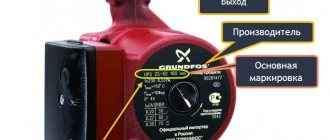Why is the drainage pump and station not suitable?
Pumping stations and drainage pumps are not suitable for automatic irrigation systems!
PUMPING STATIONS are not suitable for irrigation systems, because... The hydraulic accumulator performs a function incompatible with irrigation needs. It accumulates a certain amount of water so that, for example, when drawing a glass of water in the house, the pump does not turn on, but the accumulator releases it. Using a pumping station for irrigation will cause the pressure switch to operate inappropriately frequently. In irrigation, the entire performance of the pump is used and the hydraulic accumulator is simply superfluous, and instead of a pressure switch, you need automation with control of water flow. The DRAINAGE PUMP pumps a lot of water, but does not create enough pressure. It is designed for pumping large volumes of water without resistance (for example, from a pit to the surface of the earth). Irrigation requires high pressure (3-5 Atm), so this pump is NOT SUITABLE.
For irrigation, either surface or submersible centrifugal pumps are used. Their line includes high-performance and high-pressure pumps that meet the requirements of irrigation systems.
This section is an appendix to the article on designing an irrigation system.
Pump characteristics are reflected in the pump diagrams. Any pump manufacturer you choose will provide pump diagrams. They are often publicly available on the Internet on manufacturers' websites.
The diagram shows the dependence of pump performance on the pressure created by the pump. H – Head (pressure). Every 10 meters of lift = 1 Bar (Atm) Q – Pump capacity
Why do you need to do the calculation?
A circulation pump installed in a heating system must effectively solve two main problems:
- create such a liquid pressure in the pipeline that will be able to overcome the hydraulic resistance in the elements of the heating system;
- ensure constant movement of the required amount of coolant through all elements of the heating system.
In order for the circulation pump to be able to cope with the above tasks, such a device should be selected only after the heating calculation has been made.
When performing this calculation, two main parameters are taken into account:
- the building's total heat energy requirement;
- the total hydraulic resistance of all elements of the created heating system.
Table 1. Thermal power for various rooms
After determining these parameters, you can already calculate the centrifugal pump and, based on the obtained values, select a circulation pump with the appropriate technical characteristics. A pump selected in this way will not only provide the required coolant pressure and its constant circulation, but also operate without excessive loads, which can cause rapid failure of the device.
Selection of pump by pressure and flow
Pressure The operating pressure created by the pump must be no less than the operating pressure at which the irrigation nozzles operate (indicated in the nozzle catalogues). For example, MP Rotator nozzles from HUNTER operate at a pressure of 2.5 - 3 bar. Performance The pump performance should be no less than the needs of the largest irrigation area.
How to work with a pump diagram
Let's assume that we are selecting a pump for an irrigation system with 1-inch-sized watering zones with the required parameters: - operating pressure of the nozzles -
3 Bar (H = 30 m) - productivity of one zone 3 m3/h On the diagram on the vertical scale we find the value of 30 m ., and horizontally - a value of 3 m3/h.
We draw a perpendicular from the pressure value of 30 m from the vertical scale to the intersection with the pump line (blue lines). Then, from the point of intersection with the pump line, lower the line vertically down until it intersects with the horizontal scale - it will indicate the performance of this pump at a pressure of 3 Bar. Resistance LOSSES
When choosing a pump, you must take into account resistance losses, which are inevitably present in any plumbing system.
Where do losses accumulate? — losses along the length of the pipe . For every 100 m of pipe length, about 1 bar of pressure is lost, which is created by the pump - losses in fittings
.
Local resistance is created in tees, bends and any fittings. — losses due to water rise . The rise of water for every 10 m requires an additional 1 bar of pressure. — suction losses .
Significant resistance is created at the suction pipe. Therefore, the suction pipe should not be longer than 10 m and have a larger diameter than the pressure pipe. Minimum resistance must be ensured along the suction path. Try to get rid of the situation where the surface pump is located above the water level, because... surface pumps work very poorly to lift water from depth. Losses due to water rise = 2 Bar for every 10 m depth. All these losses translate into additional pressure that must be added when selecting a pump. Example : Initial required parameters of an irrigation system: - pressure = operating pressure of nozzles = 3 Bar - productivity of one zone = 3 m3/h For example, we accept conditional losses: - 100 m to the valve furthest from the pump - add an additional 1 Bar of pressure on the pump. — 2 m height difference from the pump to the highest point with nozzles. Add an additional 0.2 bar of pressure to the pump. — let’s say there are no losses at the suction, because the container and the pump are located next to each other at the same level. TOTAL: Additional losses require increasing the initial design pressure of the pump by 1.2 Bar
Accordingly, in the diagram, when selecting a pump, on the pressure scale you need to select the value 4.2 Bar (3+1.2=4.2)
This diagram does not show the pump you are looking for, so you need to look in the line of more powerful pumps.
Areas of use of circulation pumps
The main task of the circulation pump is to improve the circulation of coolant through the elements of the heating system. The problem of already cooled water entering heating radiators is well known to residents of the upper floors of apartment buildings. Such situations are associated with the fact that the coolant in such systems moves very slowly and has time to cool before it reaches parts of the heating circuit located at a considerable distance.
When operating autonomous heating systems in country houses, in which water circulates naturally, you may also encounter a problem when radiators installed at the farthest points of the circuit barely heat up. This is also a consequence of insufficient coolant pressure and its slow movement through the pipeline. The installation of circulation pumping equipment allows you to avoid such situations both in apartment buildings and in private houses. By forcibly creating the required pressure in the pipeline, such pumps provide high speed movement of heated water even to the most distant elements of the heating system.
The pump increases the efficiency of existing heating and allows you to improve the system by adding additional radiators or automation elements
Heating systems with natural circulation of liquid that transfers thermal energy are effective when they are used to heat small houses. However, if you equip such systems with a circulation pump, you can not only increase the efficiency of their use, but also save on heating by reducing the amount of energy consumed by the boiler.
In terms of its design, the circulation pump is a motor whose shaft transmits rotation to the rotor. A wheel with blades is installed on the rotor - an impeller. Rotating inside the working chamber of the pump, the impeller pushes the heated liquid entering it into the discharge line, forming a coolant flow with the required pressure. Modern models of circulation pumps can operate in several modes, creating different pressures of the coolant moving through them in heating systems. This option allows you to quickly warm up the house when cold weather sets in by running the pump at maximum power, and then, when a comfortable air temperature has formed throughout the building, switch the device to an economical operating mode.
Circulation pump device for heating
All circulation pumps used to equip heating systems are divided into two large categories: devices with a “wet” and “dry” rotor. In pumps of the first type, all rotor elements are constantly in the coolant environment, and in devices with a “dry” rotor, only a part of such elements are in contact with the pumped medium. Pumps with a “dry” rotor are distinguished by greater power and higher efficiency, but they make a lot of noise during operation, which cannot be said about devices with a “wet” rotor, which produce a minimal amount of noise.
Selection by tables
Some manufacturers accompany their products not with diagrams, but with tables with characteristics. Using the tables it will also be easy to select a pump.
Let's take as an example a surface pump of the nipump MH series
1) Find the closest performance value. We select a value of 3.6 m3/h (the closest value on the larger side of the required one) 2) We find the pressure value closest to the required one 49 m (4.9 Bar) 3) Thus we see which pump corresponds to these parameters
How to correctly calculate pump performance
Such an important parameter of a circulation pump as its performance indicates how much coolant it can move per unit of time. Calculation of the performance of the circulation pump, which is designated by the letter Q, is carried out using the following formula:
Q = 0.86R/TF–TR.
The parameters used in this formula are shown in the table.
Table 2. Coolant parameters for calculating pump performance
The amount of heat required by the premises of a house to heat them, which is designated by the letter R, is determined depending on the climatic conditions of the area in which such a house is located. So, for houses that are operated in European climates, choose the following values for this parameter:
- private houses of small and medium size - 100 kW per 1 m2;
- apartment buildings - 70 kW per 1 m2 of their premises.
If the calculation of heating pump performance is carried out for buildings with low thermal insulation characteristics, the value of thermal power inserted into the formula should be increased. For industrial premises, as well as premises located in buildings with good thermal insulation, the value of the parameter R is taken equal to 30–50 kW/m2.
Automation for pump
For reliable operation of any pump and the entire water supply system, it is necessary to ensure its operation with the specified parameters, protect it from dry running, frequent switching on and off, low or high water pressure at the inlet and outlet. To ensure all these parameters, it is necessary to purchase and equip the pump with automation.
The automatic watering pump should only work in the irrigation system, without wasting water on outside consumers, because the pump has no free capacity.
Automatic pump control turns on the pump according to the water flow. The flow sensor “sees” the movement of water through the pipe and turns on the pump and, when the movement stops, stops the pump.
Audit of industrial water supply systems
Pumps used in closed circulation systems can operate virtually uninterrupted, and often operate around the clock. At any production there are technical personnel responsible for the trouble-free operation of the pumps, who must carry out daily inspections.
- It is necessary to constantly monitor the smooth start-up and operation of the mechanism, identify vibrations and beating in the unit or pipeline. The main attention is paid to the condition of flange connections and couplings, mounting the unit on the foundation, lubrication of oil seals and the temperature of pump bearings. High-quality lubrication is very important for them - the oil is changed at the time specified by the manufacturer.
Monitoring the condition of pumping equipment in production
- Most often, the scheme is as follows: the first cleaning of the bearings with an oil change occurs quite quickly, after two hundred hours of pump operation. The next replacement can be made after two thousand hours of operation - this is approximately once a year. The higher the quality of the oil, the longer this period can be.
- During operation of the unit, some parts wear out faster than others, and this is normal. Much depends on the temperature of the pumped liquid, the presence of abrasive impurities in it, and the level of vacuum in the suction part. First of all, bushings and sealing rings and stuffing box become unusable.
- The manufacturer allots a certain period of time for their operation, after which, without waiting for a breakdown, the pump must be sent for major repairs. After the audit, control tests are carried out, based on the results of which the unit can be reintroduced into the system.
The timing of inspections and overhauls of pumping equipment is established according to the actual operating conditions of the pumps, but taking into account the manufacturer’s recommendations. In production, an inspection log is kept for each unit, where the readings of instrumentation, the condition of the main components and the dates of equipment maintenance are recorded.
Resistance
In addition to the need to push water to a certain height, the pump must be able to overcome the resistance created in the pipeline. A pipe that is too narrow will increase resistance and system performance will decrease, while a pipe that is too wide will require unnecessary costs. The diameter of the water conduit should be optimally selected to avoid unnecessary resistance.
To calculate the resistance, check out the pressure loss graph for a pipe of a specific type and diameter: this way you can calculate the losses for a certain volume of water. If there is no graph or you don’t want to count, use the simple recommendation below:
Recommended HDPE pipe diameter:
- flow up to 1.5 m3/hour – 25 mm
- flow up to 3 m3/hour – 32 mm
Well pump calculator from Vodomaster
The Vodomaster.ru online store values the trust of its customers and takes care of keeping their personal data secret from scammers and third parties. The Privacy Policy is designed to ensure that personal information provided by users is protected from access by third parties.
The main purpose of collecting personal data is to ensure adequate protection of information about the User, incl. his personal data from unauthorized access and disclosure to third parties, improving the quality of service and the efficiency of interaction with the client.
BASIC CONCEPTS
Website – online store “Vodomaster.ru”, located on the Internet at the address: vodomaster.ru
User is an individual or legal entity who has posted his personal information through any Feedback Form on the site with the subsequent purpose of transferring data to the Site Administration.
Feedback form is a special form where the User places his personal information for the purpose of transferring data to the Site Administration.
User Account (Account) – a User account that allows you to identify (authorize) the User using a unique login and password. The login and password for accessing the Account are determined by the User independently during registration.
GENERAL PROVISIONS
2.1. This Policy regarding the processing of personal data (hereinafter referred to as the “Policy”) was prepared in accordance with clause 2, part 1, art. 18.1 of the Federal Law of the Russian Federation “On Personal Data” No. 152-FZ of July 27, 2006 (hereinafter referred to as the “Law”) and describes the methods of use and storage by the Vodomaster.ru online store of confidential information of users visiting the vodomaster.ru website.
2.2. By providing the online store "Vodomaster.ru" with private information through the Site, the User freely, of his own free will, consents to the transfer, use and disclosure of his personal data in accordance with the terms of this Privacy Policy.
2.3. This Privacy Policy applies only to private information obtained through the Site. Personal information is information that allows, when used separately or in combination with other information available to the online store, to identify the client’s personal data.
2.4. The site vodomaster.ru may contain links that allow you to go to other sites. The online store is not responsible for the information published on these sites and provides links to them only to ensure the convenience of users. However, this Policy does not apply to other sites. Users who follow links to other sites are encouraged to review the privacy policies posted on such sites.
CONDITIONS, PURPOSE OF COLLECTION AND PROCESSING OF USERS' PERSONAL DATA
3.1. Personal data of the User such as: first name, last name, patronymic, e-mail, telephone, delivery address, skype, etc., are transferred by the User to the Site Administration with the consent of the User.
3.2. The transfer of personal data by the User through any Feedback Form posted on the website, including through the order basket, means the User’s consent to the transfer of his personal data.
3.3. By providing his personal data, the User agrees to their processing (up to the User’s withdrawal of his consent to the processing of his personal data), in order for the online store to fulfill its obligations to the client, sell goods and provide services, provide reference information, as well as for promotion purposes goods, works and services, and also agrees to receive advertising and informational messages and service messages.
3.4. The main purposes of collecting information about the User are accepting, processing and delivering orders, providing feedback to the client, providing technical sales support, notifying about changes in the operation of the Site, providing, with the consent of the client, offers and information about promotions, arrivals of new products, advertising mailings; registration of the User on the Site (creation of an Account).
3.5. Registration of the User on the website vodomaster.ru is not mandatory and is carried out by the User on a voluntary basis.
3.6. The online store is not responsible for the information provided by the Client on the Site in a publicly accessible form.
PROCESSING, STORING AND PROTECTION OF PERSONAL INFORMATION OF SITE USERS
4.1. The Site Administration processes information about the User, incl. his personal data, such as: first name, last name, patronymic, e-mail, telephone, skype, etc., as well as additional information about the User provided by him at his own request: organization, city, position, etc.
4.2. The online store has the right to use “cookies” technology. Cookies do not contain confidential information and are not transferred to third parties.
4.3. The online store receives information about the IP address of the User of the site vodomaster.ru and information about the link from which Internet site he came from. This information is not used to identify the User.
4.4. When processing personal data of users, the online store adheres to the following principles:
- Information is processed lawfully and fairly;
- Information is not disclosed to third parties and is not distributed without the consent of the Data subject, except for cases requiring disclosure of information at the request of authorized government bodies or legal proceedings;
- Determination of specific legitimate purposes before processing (including collection) of information begins;
- Only the information that is necessary and sufficient for the stated purpose of processing is collected;
- The processing of information is limited to the achievement of specific, predetermined and legitimate purposes;
4.5. Personal information about the User is stored on the website’s electronic media indefinitely.
4.6. Personal information about the User is destroyed at the request of the User himself on the basis of his official request, or at the initiative of the Site administrator without explanation, by deleting information posted by the User.
4.7. The request for deletion of personal information sent by the User must contain the following information:
for an individual:
- number of the main identification document of the User or his representative;
- information about the date of issue of the specified document and the issuing authority;
- registration date via the Feedback Form;
- text of the appeal in free form;
- signature of the User or his representative.
for a legal entity:
- request in free form on company letterhead;
- date of registration via the Feedback Form;
- the request must be signed by an authorized person accompanied by documents confirming the person’s authority.
4.8. The online store undertakes to consider and send a response to the User’s request within 30 days from the date of receipt of the request.
4.9. The online store implements measures to protect personal data of Users in the following areas:
- preventing the leakage of information containing personal data through technical communication channels and other means;
- prevention of unauthorized access to information containing personal data, special influences on such information (data carriers) for the purpose of obtaining it, destroying it, distorting it and blocking access to it;
- protection against malware;
- detection of intrusions and computer attacks.
TRANSFER OF PERSONAL DATA
5.1. The Vodomaster.ru online store does not disclose personal information about Site Users to third parties, except in cases prescribed by Federal Law No. 152-FZ of July 27, 2006 “On Personal Data,” or when the client voluntarily agrees to the transfer information.
5.2. Conditions under which the Vodomaster.ru online store can provide private information from its databases to third parties:
- to satisfy demands, requests or court orders;
- for the purpose of cooperation with law enforcement, investigative or other government agencies. At the same time, the online store reserves the right to report to government authorities about any illegal activity without notifying the User about it;
- to prevent or investigate suspected wrongdoing, such as fraud or identity theft;
5.3. The online store has the right to use other companies and individuals to perform certain types of work, for example: delivering packages, mail and emails, removing duplicate information from customer lists, analyzing data, providing marketing services, processing credit card payments. These legal entities/individuals have access to users' personal information only when necessary to perform their functions. This information cannot be used by them for other purposes.
SECURITY OF BANK CARDS
6.1 When paying for orders in the Vodomaster.ru online store using credit cards, all transactions with them take place on the banks’ side in special secure modes. No confidential information about bank cards, except for notification of the payment made, is transmitted to the online store and cannot be transmitted.
CHANGES AND ADDITIONS
7.1. Any changes to the terms or conditions of the Personal Information Policy will be reflected in this document. The Vodomaster.ru online store reserves the right to make changes to certain sections of this document at any time without prior notice by posting an updated version of this Privacy Policy on the Site.
Conclusion
• Pressure is calculated in meters: 10 m water column = 1 bar. • Flow is measured in m3/hour (less often - l/min). • The pressure-flow characteristic is a graph that allows you to determine whether a pump is suitable for a particular well. • Well: static water level – depth of the water surface in a calm state; dynamic level - the depth below which water theoretically cannot fall; flow rate is the volume of water that a well can produce per hour. • Pipe: use the maximum permissible pipe diameter to reduce resistance • Observe the maximum and minimum pump immersion depth requirements.
Following these recommendations will allow you to independently select a well pump that is optimally suitable for inclusion in the system.
Well
For each pump model, the permissible values of foreign inclusions in the water (sand, etc.) are established. Failure to comply with the requirements leads to rapid wear and tear of the device and will void the warranty. Therefore, before selecting or buying a well pump, it is necessary to pump the well and do a water analysis.
A well is a round deep hole of small diameter with a pipe inside forming the walls. At a certain height, the pipe walls have holes, the so-called filter. There is a column of water in the well.
Before choosing a pump, find out:
• Static water level • Dynamic water level • Well flow rate
These characteristics play a key role when choosing a well pump. It is necessary to determine at what depth the water mirror, or that same static level, is located. It is called so because the water at the moment of measurement is in a calm position.
When the pump is turned on, the static level will decrease to the dynamic level: the water cannot fall below the dynamic level. The difference between the statistical and dynamic volumes of a well is called flow rate.
Important: the pump should not pump out more than the well can produce. Thus, a pump power of 3 m3/hour is absolutely not suitable for a well with a flow rate of 1.5 m3. Ideally, the pump should be slightly weaker than the well flow rate, by about 20-30%.
Find out at what depth the well filter is located. The pump should be positioned 1 m below the dynamic water level and 1 meter above the well filter. This data is usually indicated in the well passport.
So
• Static level – depth of the water surface at rest; • Dynamic level – minimum depth of the water surface; • Flow rate – volume of water (measured in liters per minute or cubic meters per hour)
